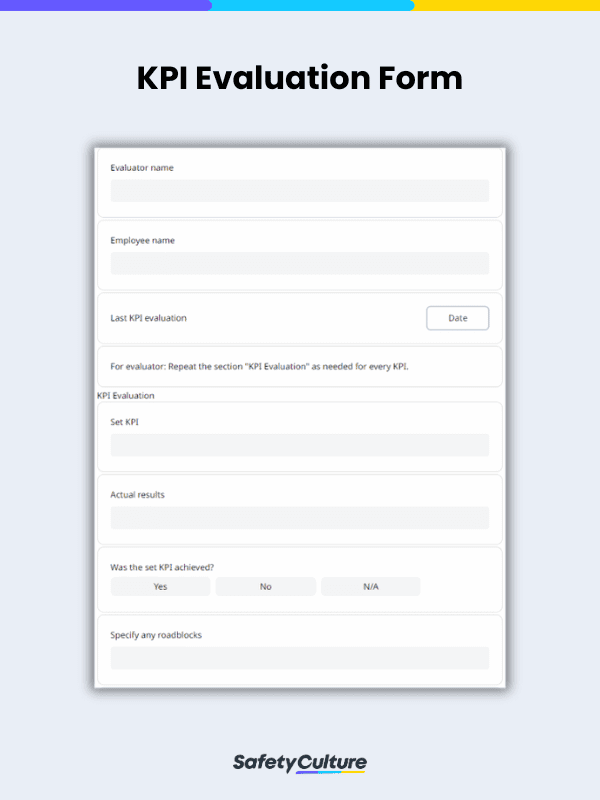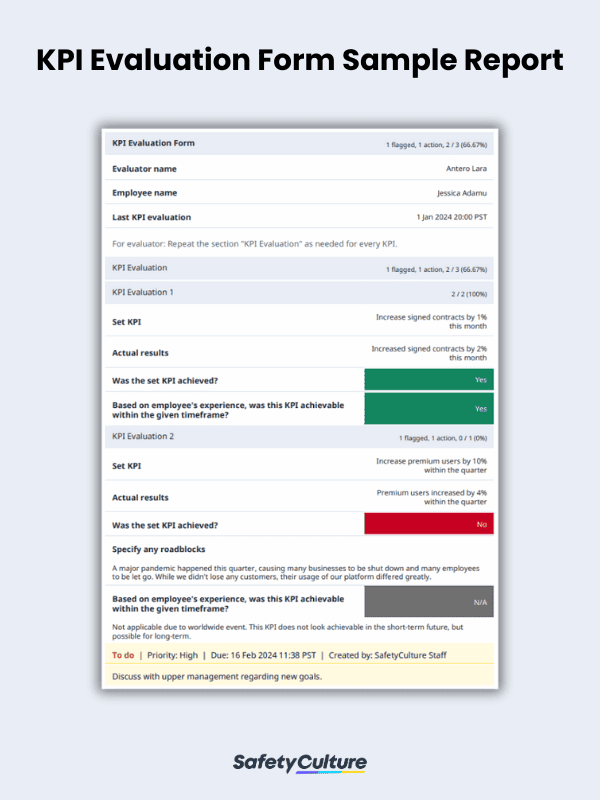What is a KPI Evaluation Form?
A KPI evaluation form is a document used to assess the performance of employees based on their Key Performance Indicators (KPI) towards a specific target. The KPI evaluation form typically consists of a set of criteria or performance indicators that are directly aligned with the organization’s goals and objectives.
Importance
A KPI evaluation form helps to track progress toward achieving desired outcomes and provides a structured framework for evaluating performance based on predefined metrics and indicators. Also sometimes referred to as a KPI audit form, it is essential to have this document when evaluating employee performance.
Primarily, a KPI evaluation form helps provide structure, consistency, and objectivity to the evaluation process. By standardizing the evaluation process for all, it becomes easier to track, measure, and compare results, as well as create new KPIs for the future. It can also assist in conducting internal audits, as reported issues can also be an organizational concern.
Additionally, it also helps with the following:
- Collecting and analyzing employee performance data
- Documenting employee growth and development
- Sharing feedback and collating it
- Promoting accountability between managers and employees and encouraging continuous improvement
Regularly evaluating KPIs with forms can also help improve your organization as a whole. By knowing your employees’ performance, roadblocks, and strengths, you can better help them find new ways to grow, which helps with company growth in turn.
What to Include in a KPI Evaluation Form
Ideally, your KPI evaluation form should have fields for the following:
- Date the evaluation is conducted
- Name of person conducting the evaluation
- Name of employee to be evaluated
- Date of last evaluation
- The employee’s set KPIs
- The employee’s actual results in regard to the KPIs set
- An evaluation of the employee’s performance, either quantified with numbers or explained in a paragraph form, depending on the standards set by upper management
- Other comments
- Signature of evaluator
The way you create and manage your KPI evaluation form should also be considered. For maximum flexibility across multiple teams and a more streamlined way of operating, it would be best to use a digital platform to do so. Going digital can save you and your organization time and money, as this way, you can store all forms in the cloud for easy reference.
Here is a sample KPI evaluation form in use for reference:
How to Use this Form
While a KPI evaluation form is most commonly used for evaluating individual performance, it can also be used in the following situations:
- Setting new KPIs
- Creating benchmarks
- Identifying common problems and creating action plans for them
- Improve communication regarding targets and feedback
- Ensuring quality in performance
FAQs about KPI Evaluation Forms
The frequency of filling out KPI evaluation forms can vary depending on the specific needs and context of an organization. Typically, KPIs can be reviewed and evaluated weekly, monthly, quarterly, or yearly.
When evaluating KPIs, several common challenges can arise. Some of the most common ones managers face include the following:
- Confusion in defining KPIs
- Retracing previous evaluations to use as basis for current ones
- Setting realistic targets
- Possible subjectivity and bias
- Miscommunication
The KPI evaluation form is typically managed by the organization’s performance management team or department. However, in some organizations, the KPI evaluation form can be managed by team leaders, HR professionals, and even upper management as a whole.




